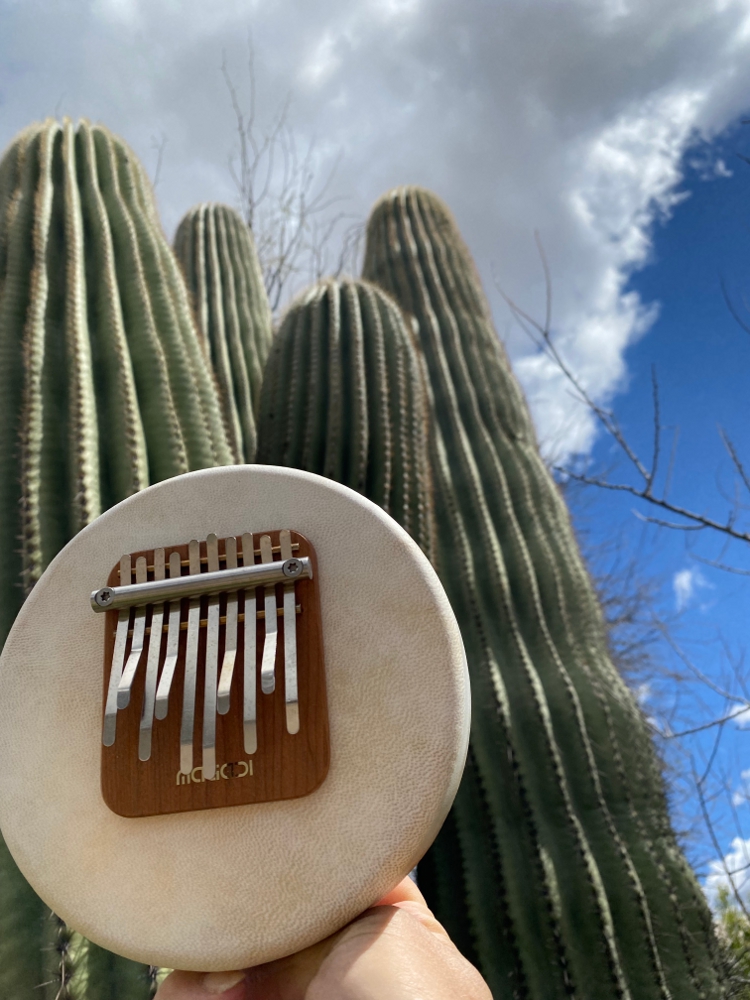
Use of this website constitutes acceptance of the Privacy Policy and User Agreement. Copyright © 2020 Kalimba Magic. All Rights Reserved.
Aboriginal peoples all across the globe have used pentatonic scales in their music. One of Hugh Tracey’s fundamental findings was that about 40% of all the kalimbas he documented in his expeditions across Africa were tuned to pentatonic scales.
Find out what makes the pentatonic scales so essential!
A pentatonic scale is any scale that has five unique notes per octave. (Most other scales have seven unique notes per octave.) On average, the notes in the pentatonic scale are farther apart from each other than in other types of scales – both tonally farther apart, and on the pentatonic kalimbas, physically farther apart as well. Putting the notes farther apart makes the pentatonic easier to play in many ways.
That extra space between the notes – both physically and in terms of pitch – makes the pentatonic kalimbas easier to play than their diatonic counterparts (that is, the Alto, Treble, or Bb Treble kalimbas). You don’t really stop and think about what notes you are going to play, because they all work together. The extra distance between adjacent tines makes it less likely that you will play a tine you didn’t intend to play. These work together to make the pentatonic kalimbas great jamming machines.
The pentatonic scale is popular in both Waldorf and Orff music instruction for essentially the same reason it was popular in primitive cultures – it is easy to make music that sounds great even if you don’t know that much about the instrument.
The major pentatonic scale in western music is defined to be the scale you get from the black notes on the piano. This is the iconic scale found in African American Spirituals such as “Nobody Knows the Trouble I’ve Seen”, “Swing Low, Sweet Chariot”, and “This Little Light of Mine”.
The minor pentatonic scale in western music is often known as the blues scale. It is made up of the same intervals as major pentatonic scale, but it starts on a different note. If you have a G major pentatonic kalimba, you can also play the E minor pentatonic scale by starting on the E instead of the G – in other words, the major and minor pentatonic scales are two sides of the same coin.
Even though the minor pentatonic scale is present on every major pentatonically tuned kalimba, some people choose to get their kalimbas tuned to the G minor pentatonic scale. Why? Because of the psychological strength of having that lowest note in the middle. If you had a major pentatonic kalimba in G, with G being the lowest note, the E – which is the root of the relative minor pentatonic scale – would be the 5th note up, halfway up the right side, and it would be hard to remember its exact location. If you really want to play in the minor pentatonic scale, you should get yourself a kalimba specially tuned to the minor pentatonic scale.
A celeste pentatonic kalimba in G major pentatonic tuning. This piece switches between G major and E minor – for example, in the video, between 10 seconds and 25 seconds, the music is in E minor.
This box pentatonic kalimba is tuned to the G minor pentatonic scale – that is, the lowest and the highest notes, both G, are also the root notes of the minor pentatonic scale.
While the previous two videos featured pentatonic scales with no half step intervals, the Japanese Ake Bono scale has two half step intervals. This is a mystical and enchanting tuning.
This is the G major pentatonic scale, the standard tuning for the Hugh Tracey Pentatonic kalimbas, with some electronic effects added. Note that at 1 minute 30 seconds, the guitar and bass shift mode to G mixolydian (marked with an F natural instead of an F sharp) – but as the G major pentatonic scale has no F at all, this kalimba plays on uneffected by that key change.
I find each of these different pentatonic tunings has a different range of emotional expression. And the best part? You can go back and forth between these tunings yourself!


Sign up for our newsletter and free resources with your email address:
We pinky promise not to spam you and to only send good stuff.
 Assist Paul Tracey Rebuild His House in Pacific Palisades
Assist Paul Tracey Rebuild His House in Pacific Palisades 8-Note Spiral Kalimba Turned into a Student Karimba
8-Note Spiral Kalimba Turned into a Student Karimba Seek to Infuse Your Musical Moments With Beauty and Magic
Seek to Infuse Your Musical Moments With Beauty and MagicUse of this website constitutes acceptance of the Privacy Policy and User Agreement. Copyright © 2020 Kalimba Magic. All Rights Reserved.